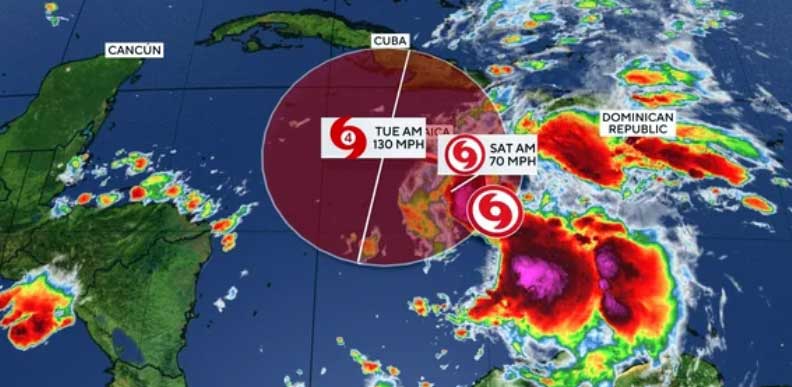Tropical Storm Melissa Expected to Intensify into Category 4 Hurricane
Tropical Storm Melissa is forecasted to rapidly intensify into a Category 4 hurricane in the Caribbean this weekend, posing a significant threat to Jamaica, Haiti, and the Dominican Republic. The National Hurricane Center (NHC) has issued a Hurricane Watch and Tropical Storm Warning for Jamaica, with hurricane conditions expected to begin by Friday afternoon.
Current Status:
Melissa is currently located about 275 miles southwest of Port-au-Prince, Haiti, and 215 miles southeast of Kingston, Jamaica. The storm is moving northwest at a slow pace of 5 mph, with maximum sustained winds of 50 mph and higher gusts. The NHC expects Melissa to continue moving slowly through the Caribbean, bringing heavy rainfall and strong winds to the region.
Potential Impacts:
The potential impacts of Tropical Storm Melissa are significant, with forecasters predicting heavy rainfall, strong winds, and large waves. The storm is expected to bring 5-10 inches of rain to southern areas of the Dominican Republic, southern Haiti, and eastern Jamaica, with potential for flash flooding and landslides. The heavy rainfall could also lead to significant flooding in low-lying areas, particularly in urban regions.
In addition to the heavy rainfall, Melissa is expected to bring strong winds, with hurricane conditions possible in Jamaica and Haiti starting Friday afternoon. The strong winds could cause significant damage to buildings, infrastructure, and vegetation, particularly in areas that are already vulnerable.
Large waves and swells are also expected along the coastlines of Hispaniola, Jamaica, and eastern Cuba, which could lead to coastal erosion and flooding. The NHC has warned of a high risk of rip currents and strong waves, which could pose a threat to swimmers and boaters.
Forecast Uncertainty:
Despite the clear threat posed by Tropical Storm Melissa, there is still some uncertainty in the forecast. The NHC notes that the storm’s track and forward speed are still uncertain, making it challenging to predict exact rainfall totals and potential impacts. Computer forecast models have yet to come into agreement on the storm’s trajectory, with some predicting a turn north over Jamaica and Hispaniola, while others bring the storm to Nicaragua in Central America.
The uncertainty in the forecast is due in part to the complex interaction between Melissa and a mid-level ridge to the north. The ridge is expected to steer the storm westward, but the strength and orientation of the ridge are still uncertain. This uncertainty makes it difficult to predict exactly where the storm will make landfall and what areas will be most affected.
Preparations:
In light of the potential threat posed by Tropical Storm Melissa, governments in the region are taking precautions to ensure public safety. Jamaica’s government has advised residents to prepare for expected impacts, with boaters returning to port and residents stocking up on supplies. The government has also activated its emergency response plan, with teams on standby to respond to any emergencies.
The Dominican Republic has suspended work in major cities, including Santo Domingo, due to the storm. The government has also issued a state of emergency, allowing for the mobilization of resources and personnel to respond to the storm.
Impact on Infrastructure:
The potential impact of Tropical Storm Melissa on infrastructure is significant. The storm’s strong winds and heavy rainfall could cause widespread power outages, damage to buildings and infrastructure, and disrupt critical services such as water and communication. The storm could also impact roads and highways, making it difficult for emergency responders to access affected areas.
Impact on Agriculture:
The storm could also have a significant impact on agriculture, particularly in areas that are already vulnerable. The heavy rainfall and strong winds could damage crops, particularly coffee, cocoa, and plantains, which are critical to the local economy. The storm could also impact livestock, particularly in areas where farmers are already struggling to cope with the effects of climate change.
Impact on Human Health:
The storm could also have a significant impact on human health, particularly in areas with poor sanitation and hygiene. The heavy rainfall and flooding could contaminate water sources, leading to an increased risk of waterborne diseases. The storm could also disrupt healthcare services, making it difficult for people to access medical care.
Conclusion:
Tropical Storm Melissa poses a significant threat to Jamaica, Haiti, and the Dominican Republic. The storm’s potential impacts are significant, with forecasters predicting heavy rainfall, strong winds, and large waves. While there is still uncertainty in the forecast, it is essential for residents in the region to take precautions and prepare for the worst. Governments in the region are taking steps to ensure public safety, but more needs to be done to mitigate the impact of the storm.
In the coming days, it is essential to monitor the storm’s progress and take necessary precautions to ensure safety. This includes stocking up on supplies, staying informed about the storm’s track and potential impacts, and following evacuation orders if necessary. With preparation and caution, it is possible to minimize the impact of Tropical Storm Melissa and ensure the safety of those in the affected regions.
Recommendations:
- Residents in affected areas should stock up on supplies, including food, water, and medication.
- Boaters should return to port and secure their vessels.
- Governments should continue to monitor the storm’s progress and take necessary precautions to ensure public safety.
- Emergency responders should be on standby to respond to any emergencies.
By taking these precautions, it is possible to minimize the impact of Tropical Storm Melissa and ensure the safety of those in the affected regions.
Read Alos
Protect Your Home and Business: Tips on Hurricane and Flood Insurance in the USA
As hurricane season approaches, it’s essential to review your insurance coverage to ensure you’re protected against potential losses. Here are some valuable tips on hurricane and flood insurance in the USA:
Understand Your Policy
- Know what’s covered: Review your policy to understand what’s covered and what’s not. Typically, standard homeowners insurance policies cover wind damage, but flood damage may require a separate policy.
- Flood insurance: Consider purchasing flood insurance, especially if you live in a high-risk flood zone. The National Flood Insurance Program (NFIP) offers flood insurance policies.
Types of Insurance
- Homeowners insurance: Covers damage to your home and personal property from wind, hail, and other perils.
- Flood insurance: Covers damage to your home and personal property from flooding.
- Windstorm insurance: May be required in coastal areas prone to hurricanes.
Tips for Filing Claims
- Document damage: Take photos and videos of damage to your property.
- Keep receipts: Keep receipts for repairs and replacements.
- File claims promptly: File claims as soon as possible to avoid delays.
Prevention and Mitigation
- Mitigate damage: Take steps to mitigate damage, such as installing storm shutters or impact-resistant windows.
- Elevate your home: Consider elevating your home to reduce flood risk.
- Regular maintenance: Regularly inspect and maintain your property to prevent damage.
Additional Tips
- Review your policy limits: Ensure your policy limits are sufficient to cover rebuilding costs.
- Consider additional coverage: Consider additional coverage for items like jewelry, art, or collectibles.
- Work with a reputable insurer: Choose an insurer with a good reputation and financial stability.
Resources
- National Flood Insurance Program (NFIP): Offers flood insurance policies and resources.
- Federal Emergency Management Agency (FEMA): Provides disaster relief and resources.
- Insurance Information Institute (III): Offers information and resources on insurance topics.
By following these tips, you can help protect your home and business from hurricane and flood damage. Review your insurance policy today and take steps to mitigate potential losses.







